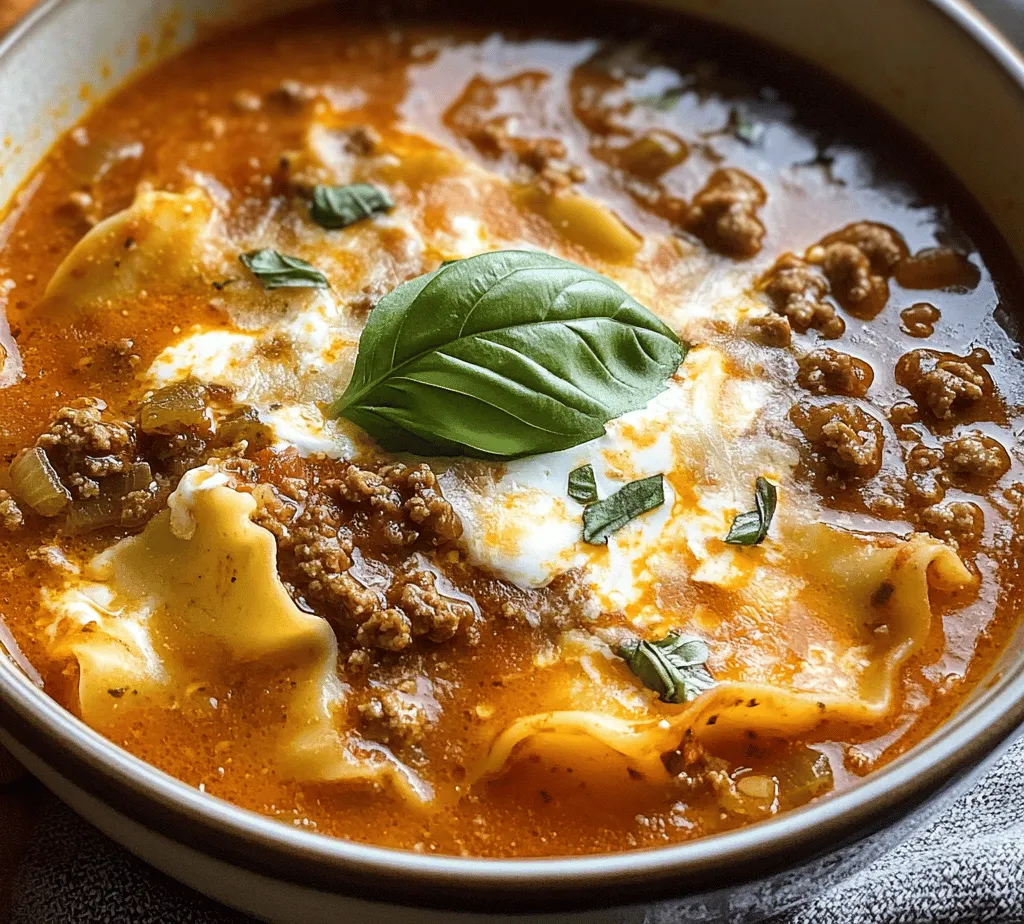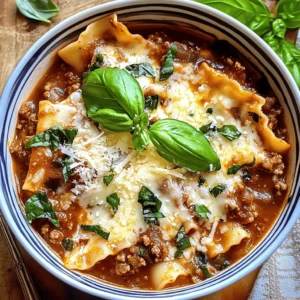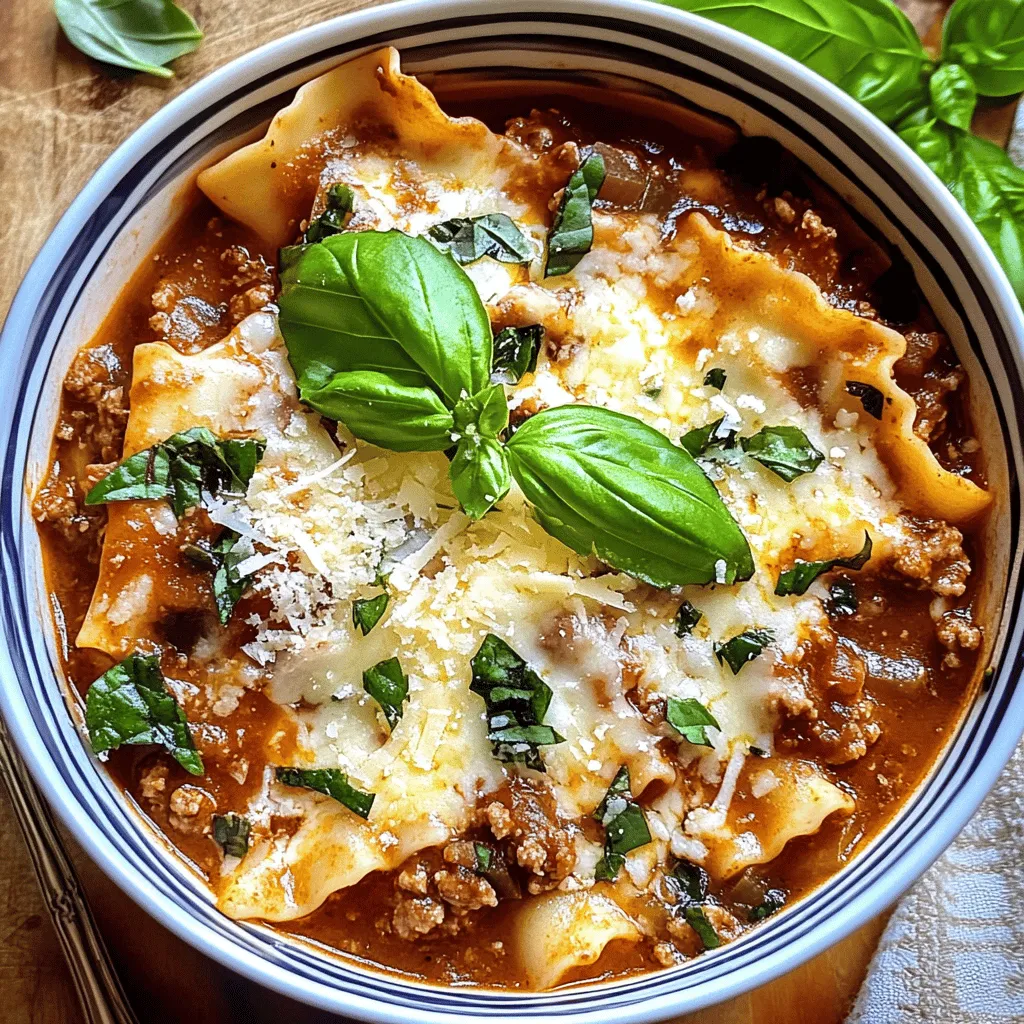Introduction
Lasagna soup is the epitome of comfort food, combining the heartwarming flavors of traditional lasagna in a cozy, soup form. It’s a dish that warms both the stomach and the soul, perfect for chilly evenings or any time you crave a hearty meal. This recipe stands out not just for its deliciousness but also for its simplicity. In under an hour, you can prepare a meal that rivals your favorite Italian restaurant’s lasagna.
What makes this lasagna soup particularly appealing is its versatility. You can easily customize it to suit your tastes or dietary needs. Whether you prefer ground beef, turkey, or even a vegetarian option, the ingredients can be swapped out to create your perfect bowl of comfort. With fresh vegetables, rich tomatoes, and a cheesy blend, this soup is a delightful twist on the classic lasagna that the whole family will love. Join me as we dive into the step-by-step process of making the best lasagna soup that will surely become a staple in your kitchen.
Understanding Lasagna Soup
Lasagna soup, as the name suggests, takes the essential components of lasagna—meat, cheese, noodles, and sauce—and transforms them into a warm, comforting soup. Originating from the desire to simplify the traditional lasagna preparation, lasagna soup delivers all the beloved flavors without the fuss of layering and baking. This dish has gained popularity in recent years for its ease of preparation and ability to feed a crowd with minimal effort.
One of the significant appeals of lasagna soup compared to its baked counterpart is its adaptability. While traditional lasagna can be heavy and time-consuming to prepare, soup offers a lighter, quicker alternative. It allows for the inclusion of various vegetables, making it a great option for those looking to increase their intake of nutritious ingredients. The broth-based soup can be packed with nutrients, particularly if you use plenty of fresh vegetables alongside lean meats, contributing to a well-rounded meal that is both satisfying and healthy.
Essential Ingredients for the BEST Lasagna Soup
Ground Beef or Italian Sausage: Choosing the Right Meat
The base of any lasagna soup is the meat, and you can choose between ground beef or Italian sausage depending on your flavor preference. Ground beef provides a classic taste, while Italian sausage adds a spicy kick that can elevate the entire dish. If you’re looking for a lighter option, ground turkey or chicken also work well. Choose quality meat for the best flavor; if possible, opt for lean cuts to keep the soup healthier without sacrificing taste.
The Role of Aromatics: Onion and Garlic in Flavor Development
No soup is complete without aromatics, and in this recipe, onion and garlic play pivotal roles in building a robust flavor profile. Sautéing these ingredients until they are fragrant and golden brown creates a delicious base for your soup. The sweetness of the onion balances the savory notes of the meat and tomatoes, while garlic adds an irresistible aroma that entices everyone to the dinner table.
Importance of Crushed Tomatoes and Beef Broth for a Rich Base
The heart of lasagna soup lies in its rich, flavorful broth. Crushed tomatoes serve as the primary source of liquid and provide the essential tomato flavor that is synonymous with lasagna. They create a luscious sauce that envelopes the other ingredients beautifully. Pairing the crushed tomatoes with beef broth enhances the depth of flavor, giving the soup a homemade taste that will impress even the most discerning palates.
Cheese Varieties: Ricotta, Mozzarella, and Parmesan Explained
Cheese is a non-negotiable component of any lasagna soup, contributing creaminess and richness that makes each spoonful delightful. Ricotta cheese adds a smooth texture, while mozzarella provides that melty, gooey quality we all love. Parmesan cheese, on the other hand, offers a sharp, nutty flavor that rounds out the cheese blend. Together, these cheeses provide the comforting essence of lasagna in a soup form. You can also experiment with other cheese varieties based on your preferences or what you have on hand.
Herbs and Spices: Basil, Oregano, and Red Pepper Flakes for Enhanced Taste
To elevate the flavor of your lasagna soup, adding the right herbs and spices is essential. Dried basil and oregano are classic Italian herbs that enhance the overall taste and aroma of the dish. A pinch of red pepper flakes can add just the right amount of heat to balance the richness of the soup. Fresh herbs can also be used as a garnish or stirred in towards the end of cooking for a burst of flavor.
Lasagna Noodles: Why Breaking Them Enhances the Dish
Unlike traditional lasagna, where sheets of pasta are layered, lasagna soup calls for breaking the lasagna noodles into smaller pieces. This not only allows for easier eating but also ensures that the noodles soak in the flavor of the broth, making every bite more enjoyable. The broken noodles will absorb the soup’s rich flavors while still maintaining a satisfying texture. You can use regular lasagna noodles or whole wheat for a healthier twist.
Step-by-Step Instructions for Preparation
Cooking the Meat: Techniques for Browning and Flavor Development
Begin by heating a large pot or Dutch oven over medium-high heat. Add your choice of ground beef or Italian sausage, breaking it apart with a wooden spoon as it cooks. The goal is to achieve a nice brown color on the meat, which adds depth to the overall flavor of the soup. Browning the meat properly is crucial; it creates a delicious caramelization that enhances the soup’s taste.
As the meat cooks, season it with a pinch of salt and black pepper to enhance its flavor. Once browned, use a slotted spoon to transfer the cooked meat to a plate, leaving any rendered fat in the pot. This fat will help flavor the aromatics that follow.
Sautéing Aromatics: Importance of Timing and Order
In the same pot, add a tablespoon of olive oil if needed, then throw in the chopped onion. Sauté the onion for about 3-5 minutes, or until it becomes translucent and fragrant. Next, add minced garlic and continue to sauté for an additional minute. Be careful not to let the garlic burn, as it can turn bitter quickly.
Once the aromatics are softened, return the browned meat to the pot. Stir everything together, allowing the flavors to meld before adding the crushed tomatoes and beef broth. This step is essential for developing a rich, layered flavor that defines your lasagna soup.
With these initial steps complete, you’re on your way to creating a warm and inviting dish that brings the essence of lasagna into a comforting soup form. Stay tuned for the next part, where we’ll delve into the remaining steps and tips for the best lasagna soup experience.

Creating the Soup Base: Combining Tomatoes, Broth, and Seasonings
To create the perfect soup base for your lasagna soup, start by selecting high-quality canned tomatoes. San Marzano tomatoes are an excellent choice due to their rich flavor and low acidity, but any good-quality diced or crushed tomatoes will work. Begin by heating a large pot over medium heat and adding a tablespoon of olive oil. Once the oil is hot, toss in a finely chopped onion and a couple of minced garlic cloves. Sauté these ingredients until the onion becomes translucent and fragrant, which usually takes about 3-5 minutes.
Next, add your tomatoes to the pot. If using whole canned tomatoes, crush them gently with a spoon as you add them. Pour in 4 cups of vegetable or chicken broth, which will provide depth to your soup. Now, it’s time to season your base. Sprinkle in a teaspoon of dried oregano, a teaspoon of dried basil, and a pinch of red pepper flakes for a hint of heat. Season with salt and pepper to taste. Allow the mixture to come to a gentle simmer, letting the flavors meld together for about 10-15 minutes. This simmering process is crucial, as it will form the backbone of your lasagna soup.
Cooking the Noodles: Tips for Achieving Perfect Tenderness
When it comes to the noodles in your lasagna soup, it’s essential to achieve the right texture. You can either use traditional lasagna noodles or opt for a quicker cooking pasta like fusilli or penne. If you choose lasagna noodles, break them into pieces that are about 2 inches long. This will mimic the layers of a traditional lasagna and make for easier eating.
Once your soup base has simmered, bring the heat to medium-high and add the broken noodles directly to the soup. Cook them according to the package instructions, usually around 8-10 minutes, or until they are al dente. It’s crucial not to overcook the noodles, as they will continue to soften in the hot soup. This method allows the noodles to soak up the flavors of the broth while maintaining a satisfying bite.
Preparing the Cheese Mixture: Balancing Flavors and Textures
No lasagna is complete without cheese, and your soup is no exception. To prepare the cheese mixture, combine 15 ounces of ricotta cheese with 1 cup of shredded mozzarella and half a cup of grated Parmesan cheese in a bowl. For added flavor, mix in a pinch of salt, a dash of black pepper, and a handful of fresh chopped parsley or basil. This mixture will add a creamy, decadent element to your soup that is reminiscent of traditional lasagna.
Once your noodles are cooked, it’s time to serve. In each bowl, add a generous spoonful of the cheese mixture on top of the hot soup. As you pour the soup over the cheese, it will start to melt and create a delightful creaminess that elevates the dish.
Combining and Serving: Techniques for Layering Flavors in Each Bowl
Serving your lasagna soup is an art form in itself. To achieve the perfect presentation, start by ladling the soup into bowls, ensuring each serving is filled with noodles, tomatoes, and broth. Top each bowl with a generous dollop of the cheese mixture, which will melt into the hot soup, creating a beautiful layered effect.
For an extra touch, sprinkle additional mozzarella and Parmesan on top, and place the bowls under a broiler for a couple of minutes until the cheese is bubbly and golden. This method will give your soup a lovely finish reminiscent of a baked lasagna.
Garnish Options: Enhancing Presentation and Flavor
To take your lasagna soup to the next level, consider adding garnishes that enhance both the flavor and visual appeal. Fresh basil leaves or parsley can add a pop of color and freshness. A drizzle of high-quality olive oil can bring richness to the dish, while a sprinkle of crushed red pepper flakes adds a touch of heat. For a bit of acidity, a squeeze of fresh lemon juice right before serving can brighten the flavors beautifully.
Cooking Tips and Techniques
Choosing the Right Pot for Cooking Lasagna Soup
A heavy-bottomed pot or Dutch oven is ideal for making lasagna soup. These types of pots distribute heat evenly and retain warmth, ensuring your soup cooks uniformly without scorching.
Adjusting Consistency: How to Thicken or Thin the Soup
If you find your soup is too thick, you can thin it out by adding more broth or water until you reach your desired consistency. Alternatively, if the soup is too thin, let it simmer uncovered for a few extra minutes to allow some of the liquid to evaporate and thicken the broth.
Alternative Cooking Methods: Slow Cooker or Instant Pot Adaptations
For those who prefer hands-off cooking methods, lasagna soup works wonderfully in both a slow cooker and an Instant Pot. For the slow cooker, combine all your ingredients (except for the noodles and cheese mixture) and cook on low for 6-8 hours. Add the noodles during the last 30 minutes of cooking, and top with cheese before serving. In the Instant Pot, sauté your aromatics, add the remaining ingredients, and cook on high pressure for 5 minutes. Quick-release the steam, stir in the noodles, and let them cook on the sauté setting until tender.
Storing and Reheating Lasagna Soup for Maximum Flavor Retention
Leftover lasagna soup can be stored in an airtight container in the refrigerator for up to 3 days. To reheat, simply warm it on the stovetop over medium heat, adding a splash of broth to loosen it up if necessary. Remember that the noodles will continue to absorb liquid over time, so it may thicken as it sits.
Nutritional Information
When it comes to enjoying a comforting bowl of lasagna soup, it’s helpful to know its nutritional breakdown. A standard serving of this lasagna soup contains approximately 400 calories, with 20 grams of protein, 15 grams of fat, and 50 grams of carbohydrates.
For those looking to lighten the recipe up, consider using low-fat ricotta and mozzarella cheese, or substitute half of the pasta with zucchini noodles for a lower-carb option. Additionally, incorporating more vegetables like spinach, bell peppers, or mushrooms can enhance the nutritional profile while adding flavor and texture.
Pairing Suggestions
To create a well-rounded meal, pair your lasagna soup with sides that complement its rich flavors. Garlic bread is a classic choice, providing a crunchy contrast to the soup. A simple side salad with mixed greens, cherry tomatoes, and a balsamic vinaigrette can offer a refreshing balance.
When it comes to beverages, consider serving a dry red wine like Chianti or a light lager beer to enhance the meal’s flavors. For non-alcoholic options, sparkling water with a splash of lemon or iced herbal tea can be refreshing accompaniments.
Conclusion
What sets this lasagna soup recipe apart is its comforting blend of flavors that capture the essence of traditional lasagna while offering a unique twist. The combination of rich tomato broth, tender noodles, and creamy cheese creates a delightful experience in every bite. We encourage you to try this recipe and enjoy the satisfaction of homemade meals that bring joy and warmth to your table. There’s nothing quite like sharing a hearty bowl of lasagna soup with loved ones, making it a perfect choice for gatherings or cozy nights in. Embrace the joy of cooking and savor the comforting flavors that this lasagna soup has to offer.



